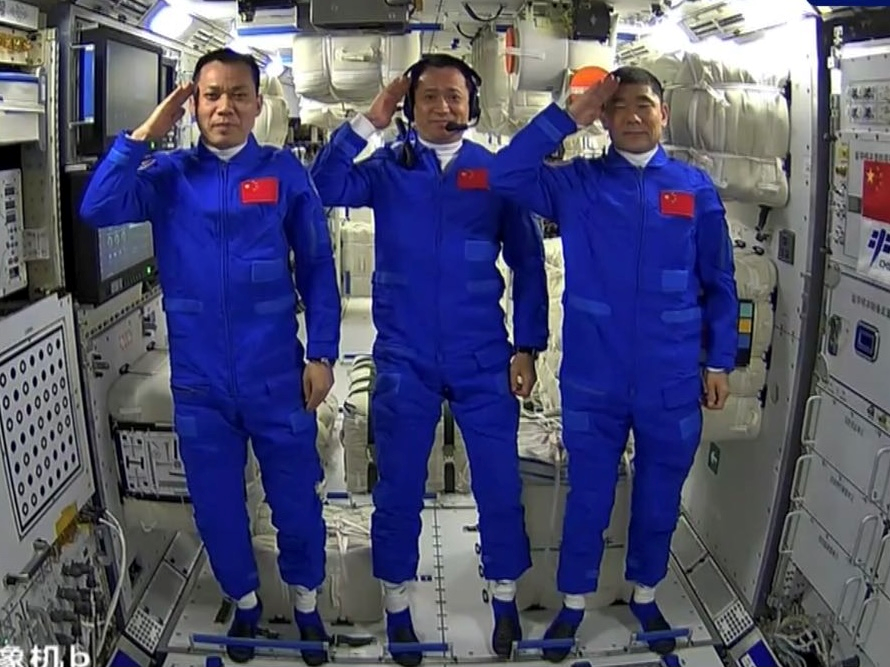
For SpaceUpClose.com & RocketSTEM
CAPE CANAVERAL, FL – In a major advance demonstrating the growing prowess of China’s technological and scientific progress China successfully launched a trio of astronauts on the country’s first human spaceflight mission since 2016 on the Shenzhou-12 capsule, Thursday, June 17- who soon rendezvoused and docked about six and a half hours later at the Tianhe core module of the new fledgling Chinese Space Station (CSS) on a flight that also doubles as the first crewed mission to the orbiting outpost circling in low Earth orbit since liftoff in late April.
The new space race with a rapidly advancing China is in full swing with the first Chinese astronaut crew now living aboard the country’s new space station following upon the recent soft landing of the Zhurong rover on Mars and the sample return of 4 pounds of Moon rocks and soil on the Chang’e-5 lunar sample return mission showing China challenging US leadership in space on all fronts.
The three astronauts aboard Shenzhou-12 comprising of two veteran and one rookie spaceflyers docked autonomously at the Tianhe core module of the Chinese Space Station dubbed Tiangong at 3:54 a.m. EDT, 3:54 p.m. BJT , 0754 GMT Thursday, June 17.
The all male trio of Shenzhou-12 crewmembers are Nie Haisheng, Commander and veteran of two prior Shenzhou missions, Liu Boming, a veteran of one mission, and Tang Hongbo, the rookie member of the crew.
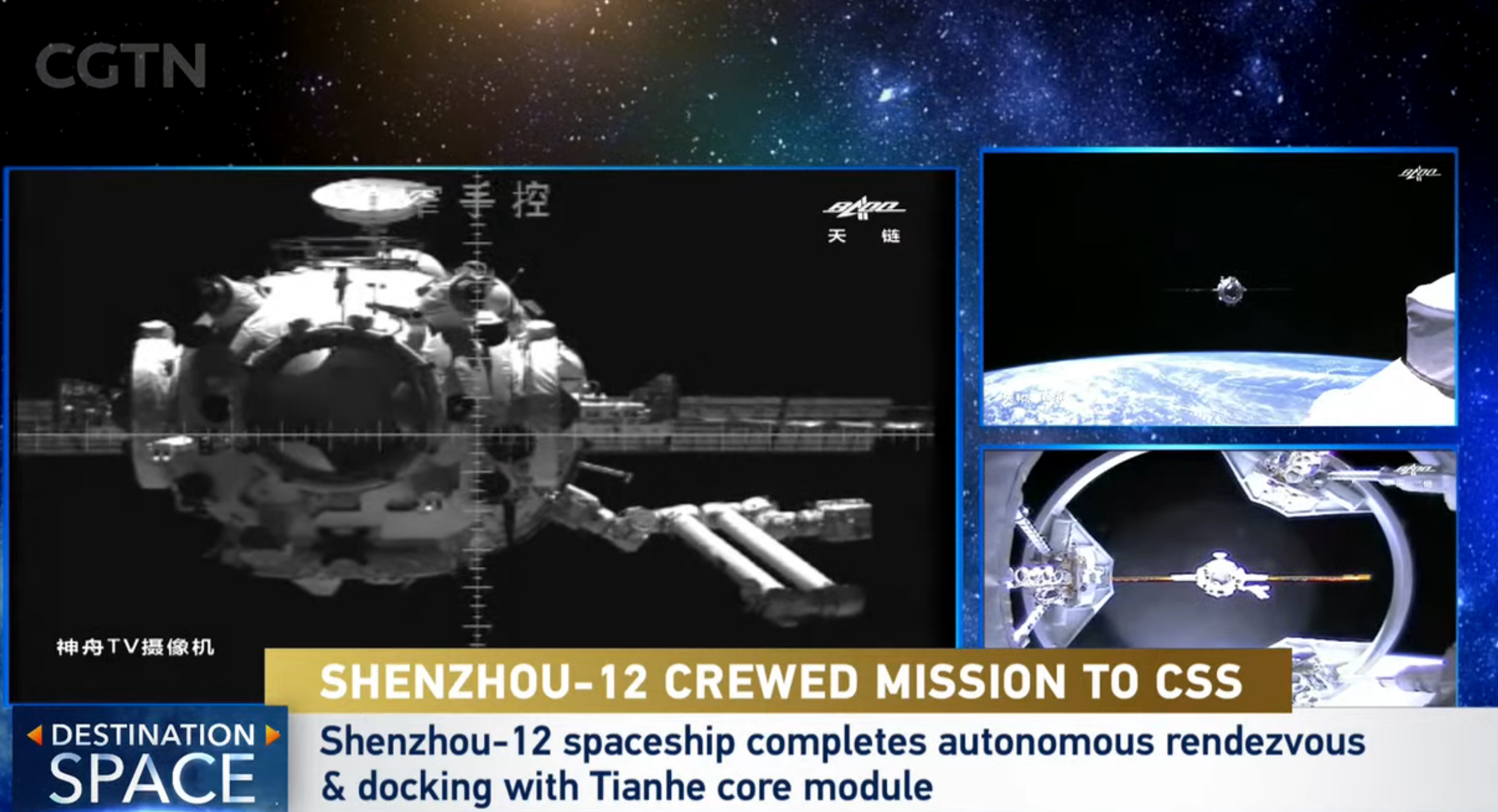
After leak checks they opened hatches and floating through the docking ring led by the commander Nie and into the Tianhe core module and gave a military style salute to the team on the ground to wide enthusiastic applause – while circling some 235 miles (380 kilometers) above Earth.
The docking was fully automated and took place exactly as planned about six and a half hours after blasting off on a 191-foot-tall (58-meter) Long March 2F rocket at 9:22 a.m. on Thursday, June 17, Beijing time, 9:22 p.m. EDT Wednesday, June 16, 0122 GMT [June 17] from China’s military operated Jiuquan Satellite Launch Center in northwest China’s Gansu Province.
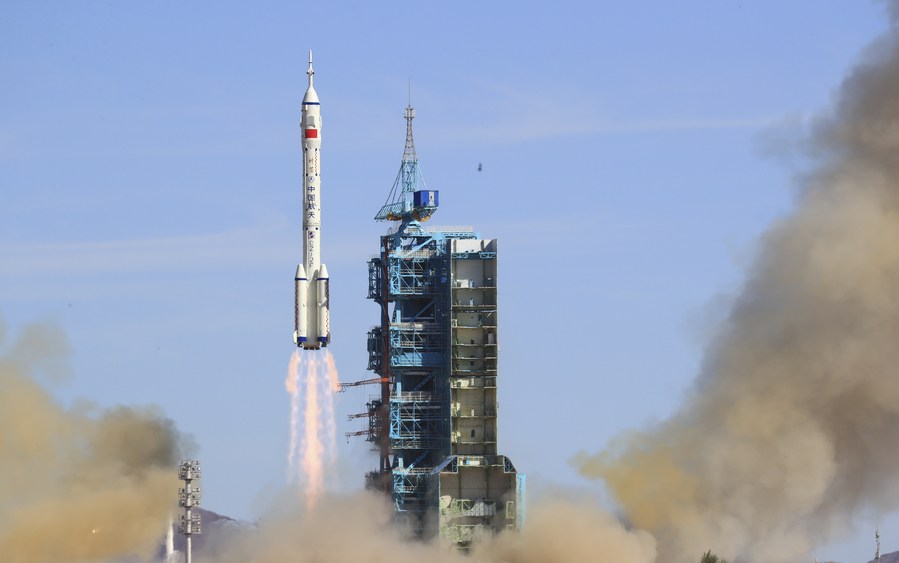
The two stage Long March-2F rocket ignited its 4 engine core stage and four strap boosters generating about 1.4 million pounds of liftoff thrust roaring off the Jiuquan launch pad.
https://twitter.com/i/events/1405495287548764164
They were jettisoned about two and a half minutes after liftoff and the second stage ignited. The launch escape tower on the top also ignited and pulled away as planned
#BREAKING China successfully launches #Shenzhou12 spacecraft #SpaceChina pic.twitter.com/3CYBnD5L7q
— CGTN (@CGTNOfficial) June 17, 2021
About 573 seconds after liftoff, the spaceship separated from the rocket and entered its planned initial orbit.
The solar panels of the spaceship unfolded on live TV broadcast by CGTN and started functioning normally and showing live views of the astronauts in good condition.
Watch: #Shenzhou12's solar panels unfold #SpaceChina pic.twitter.com/OezOkDWOqy
— CGTN (@CGTNOfficial) June 17, 2021
The Chinese military launch center director declared the launch a complete success after achieving orbit.
The Long March 2F can send payloads of up to 8.6 tons to low-Earth orbit.
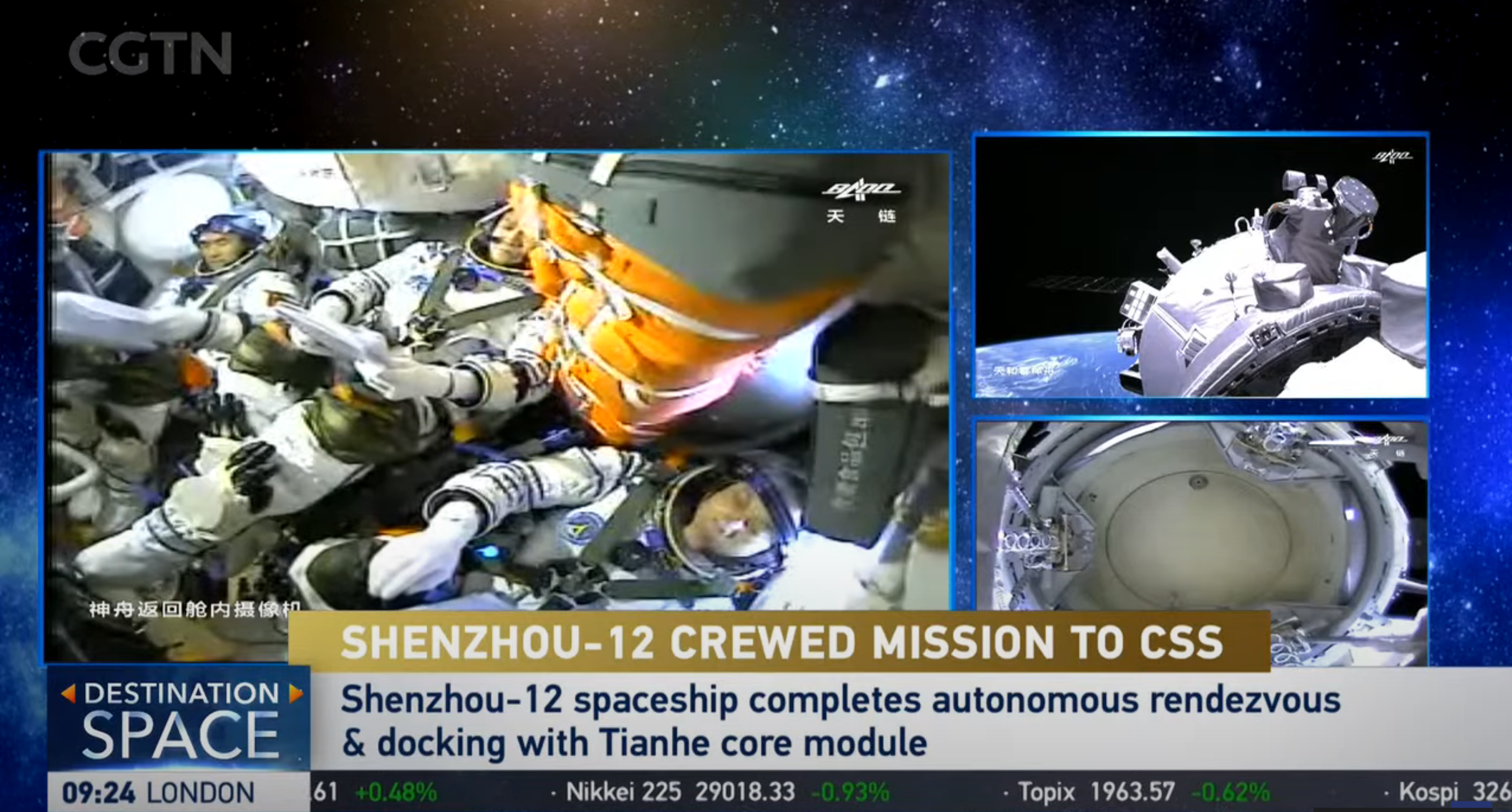
The Tianhe core module, which means “Harmony of the Heavens” serves as the docking hub and provides life support, sleeping quarters and propulsion for the Chinese Space Station.
After achieving orbit the Shenzhou-12 spaceship rendezvoused and docking in fast automated mode to the front port of the 22 ton Tianhe core module that measures 54-feet-long (16.6 meters).
Together they form the initial space station configuration with the core module and the Tianzhou-2 cargo ship attached at the rear of Tianhe.
The Shenzhou-12 launch was carried live on CGTN – China’s state affiliated TV for many hours of excellent extensive coverage.
However CGTN apparently showed a replay of the rendezvous and docking to Tianhe core module rather than a live view roughly a half hour or so after the docking events occurred.
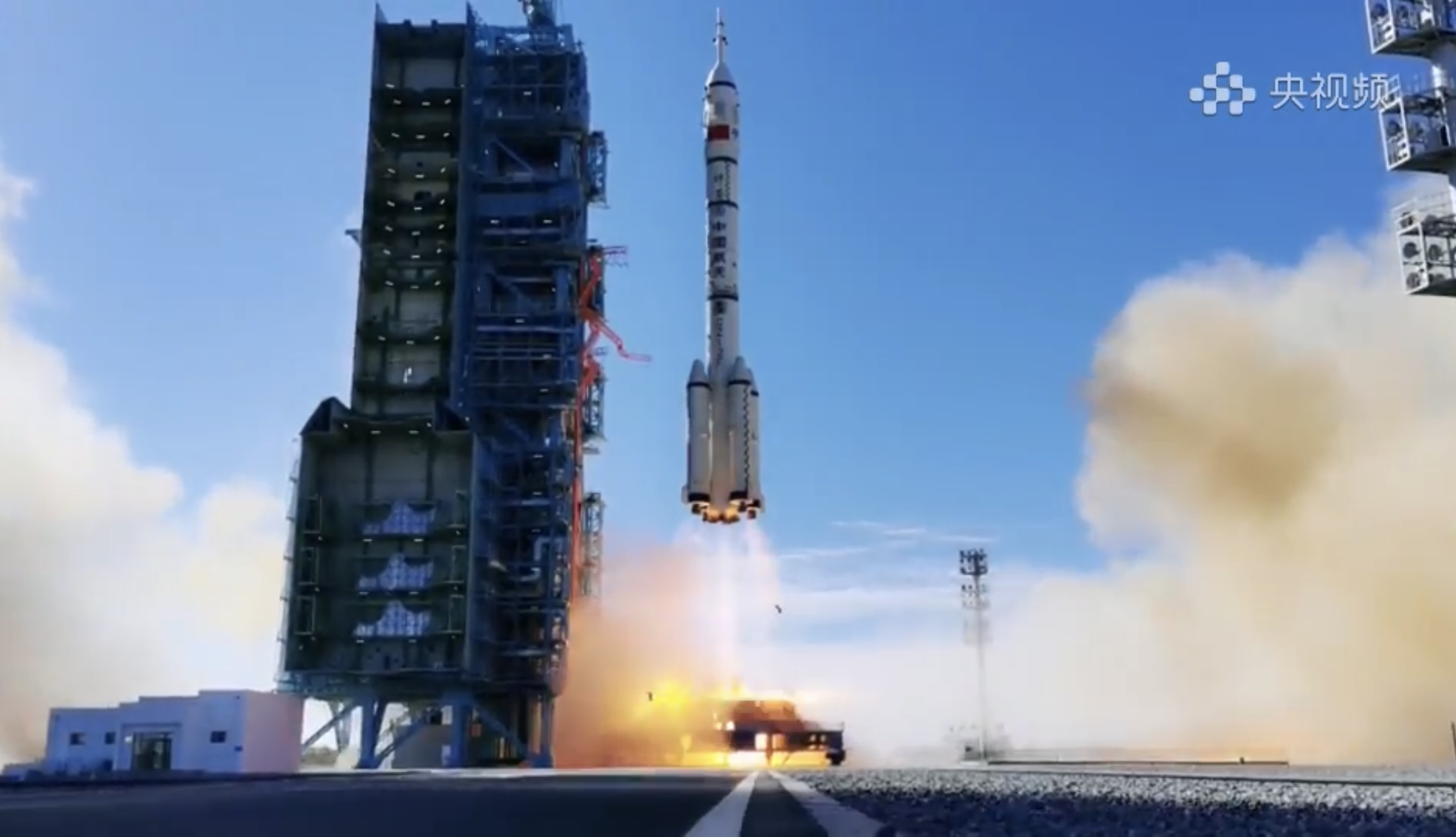
The 19 story tall Shenzhou-12 manned spacecraft and the Long March-2F carrier rocket were developed by the China Aerospace Science and Technology Corp. (CASC) that is the prime contractor for China’s space program.
The Tiangong space station is traveling in low Earth orbit circling about 390 kilometers (240 miles) above the surface and inclined about 41.5 degrees north and south of the equator.
The three Chinese astronauts will begin a three-month in-orbit residency in the combination of the Tianhe core module, the Tianzhou-2 cargo spacecraft and the Shenzhou XII manned spacecraft,”the CASC confirmed.
Now that they are on board the Chinese astronaut trio will have multiple tasks including technology verification related to the astronauts’ long-term stay in orbit, space supply replenishment, extravehicular activities and operations, and in-orbit maintenance.
Watch: #Shenzhou12 astronauts enter space station core module🧑🚀🧑🚀🧑🚀 pic.twitter.com/DC2d9AH55k
— CGTN (@CGTNOfficial) June 17, 2021
They will also be tasked with unloading the Tianzhou-2 cargo ship.
Furthermore they will carry out at least two extravehicular activities (EVAs) outside the station and operations with robotic arms outside the module for future equipment installation, repair and maintenance.
The liftoff and docking of Shenzhou-12 continues China’s fast-paced assembly schedule of the country’s new space station following the successful April 29 launch of the massive 22 ton core module named Tianhe to orbit on a Chinese Long March-5B rocket that kicked off a very ambitious series of 11 launches aiming to complete the construction of the T-shaped station by the end of next year.
The Tianhe launch was followed up by China’s Tianzhou-2 cargo ship launch on May 29 which successfully docked eight hours later on May 30 with the core module on a mission to deliver nearly seven tons of supplies, equipment, science, spacesuits and propellant to the fledgling outpost circling in low Earth orbit ahead of the first crew launch now accomplished June 17.
This marks the 15th launch of the Long March 2F rocket – with 100% success to date
Nie serves as commander of the Shenzhou 12 flight crew – after previously flying on the Shenzhou 6 mission in 2005 and Shenzhou 10 mission in 2013. He also counts as China’s oldest astronaut at age 56
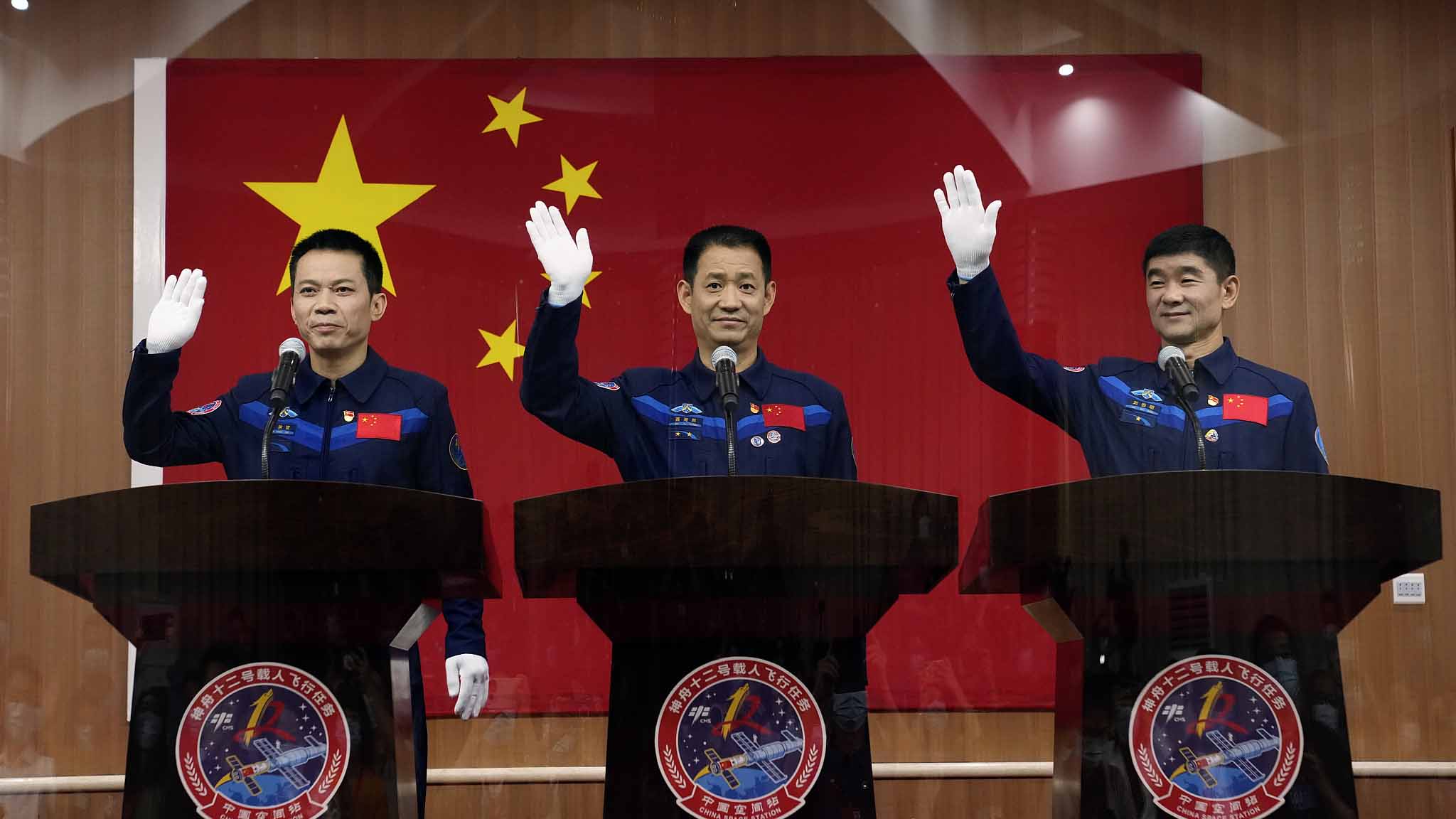
Liu previously flew on Shenzhou-7 in 2008 and is age 54
The rookie Tang was confident of success.
#Shenzhou12 crew member confident of successful space mission #SpaceChina pic.twitter.com/8QN99Wyjj4
— CGTN (@CGTNOfficial) June 16, 2021
Three other astronauts, Zhai Zhigang, Wang Yaping and Ye Guangfu, make up the backup crew.
“We have the blessings of the people, the support of the staff and the skills learned from training,” Nie told reporters at the press conference.
“I’m confident we can successfully carry out this mission.”
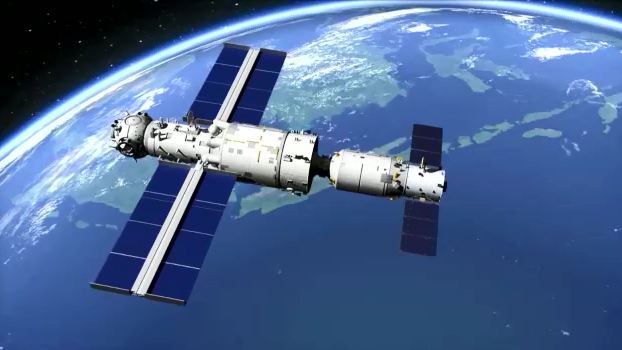
When complete the approximate 66 ton Tiangong Space Station will be about the size of Russia’s Mir space station and about 1/5 the size of the 450 ton ISS.
It has been designed for a lifespan of 10 years, but Chinese experts say it could last much longer to 15 years or more with appropriate maintenance and repairs.
The ISS has also lasted much longer than expected and its lifetime has been extended several times already.
The three-month long term stay aboard the space station by the Shenzhou-12 crew will count as China’s longest duration human spaceflight by Chinese astronauts to date.
Overall Shenzhou-12 is China’s seventh crewed spaceflight since 2003.
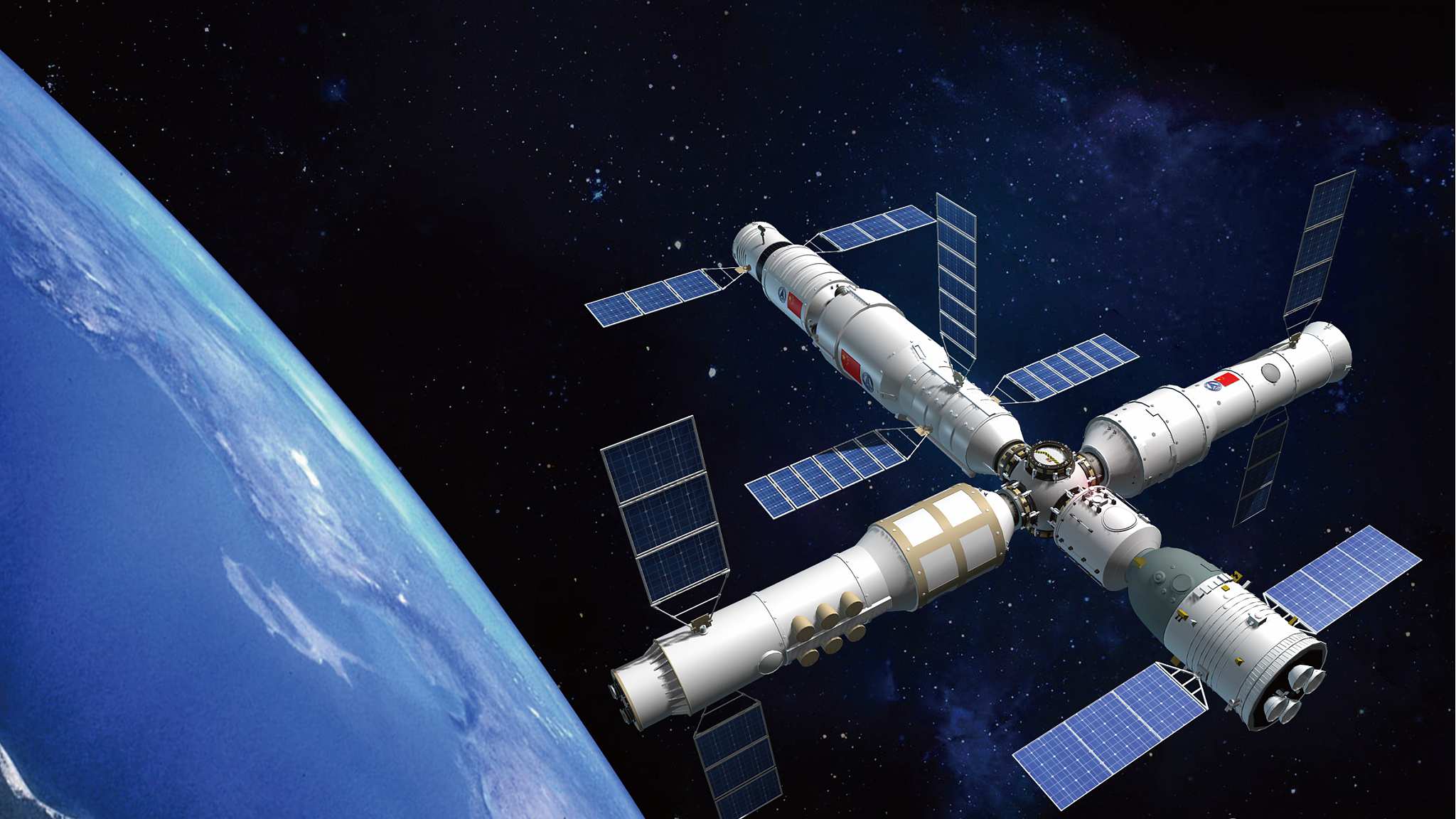
All three crew members are males selected from China’s first two astronaut selection groups, said Yang Liwei, China’s first astronaut and now a manager in the human spaceflight program in prior remarks to Chinese state media.
Female Chinese astronauts will be included on subsequent missions, Yang said.
After Shenzhou 12 departs they will be replaced by a new three person crew on the Shenzhou 13 later this year in September
“It is expected that in September and October this year, China will also carry out the Tianzhou 3 cargo spacecraft and Shenzhou 13 manned spacecraft missions,” CASC said.
The new Space Station counts as the most ambitious program ever in the history of China’s human space flight program.
China plans a series of 11 missions to complete assembly on an accelerated schedule by the end of 2022.
These 11 station assembly missions include three launches of space station modules, four cargo vessel flights, and four manned missions.
“Tianhe will act as the management and control hub of the space station Tiangong, meaning Heavenly Palace, with a node that could dock with up to three spacecraft at a time for short stays, or two for long,” said Bai Linhou, deputy chief designer of the space station at the China Academy of Space Technology (CAST), under the China Aerospace Science and Technology Corporation.
Five space station mission launches are scheduled this year and six in 2022.
Another three person crew including the first female Chinese crew member will launch later this year on the Shenzhou-13 mission for the start of routine six month stays aboard.
Two additional habitable laboratory modules that are similarly sized to Tianhe will be added next year – each with a mass of about 22 tons.
They are named the Wentian and Mengtian lab modules
The space station will take on a T shape when complete with the core module at the center and a lab capsule on each side.
At times the overall mass will reach to about 100 tons when cargo and manned spacecraft are docked.
Two additional Tianzhou cargo spacecraft and two additional Shenzhou manned spaceships will also launch next year for a total of six flights in 2022 remaining to complete the construction of the space station.
Foreign astronauts may fly to the CSS in the future especially from ESA.
“Training exchanges between astronauts from the European Space Agency and China National Space Administration have already begun. And Russia plans to cooperate with China in this field and on lunar bases as well,” CGTN reports.
Furthermore foreign science experiments will also be sent to the CSS.
“Nine were chosen in 2019, and they are being prepared once the station is put into use around 2022.”
Watch this video of the CGTN TV complete launch coverage:
Watch: Special coverage on the launch of Shenzhou-12, #China's first manned mission to CSS #SpaceChina #Shenzhou12 https://t.co/Cv8CvOJUsp
— CGTN (@CGTNOfficial) June 16, 2021
Here are further details about the Shenzhou-12 capsule from CGTN:
The Shenzhou-12 spaceship consists of a return capsule, an orbital capsule and a propulsion capsule.
At the top of the spaceship is the orbital capsule. With a rendezvous and docking mechanism at its front end, it will connect with the Tianhe core module.
As well as serving as a passage for the astronauts to enter the space station, it’s also a storage room. It has a payload capacity of 300 kilograms, and carries some samples for scientific experiments, some food and snacks, as well as fresh vegetables and fruits for the astronauts, according to Gao Xu, deputy director designer of the Shenzhou-12 spaceship at the China Academy of Space Technology.
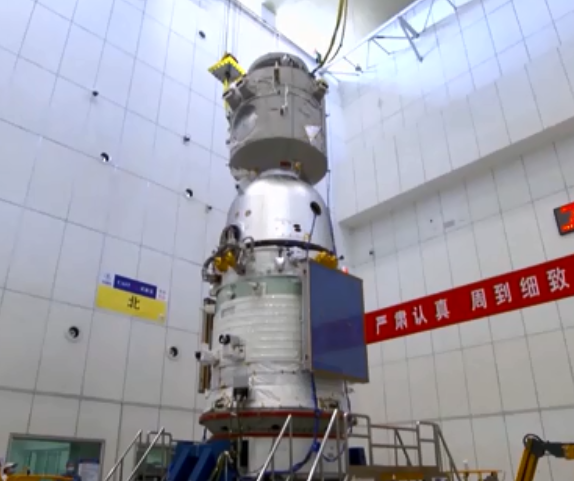
The middle section is the return capsule, the only part that will return to Earth. It is the “cockpit” for the astronauts.
Shaped like a large bell, the capsule is equipped with the control computer and communications equipment, serving as the control center of the entire spacecraft, Gao said.
The propulsion capsule is at the bottom. Installed with a propulsion system, power supply and thermal control equipment, it provides the spacecraft with energy, power and communication capabilities.
“The propulsion sub-system is made up of dozens of engines to supply power for the spaceship. The energy sub-system is mainly powered by the solar panels and batteries. The air that the astronauts need in orbit is carried in cylinders by the propulsion capsule,” said Cao Junsheng, deputy chief designer of Shenzhou-12 systems at Shanghai Academy of Spaceflight Technology.
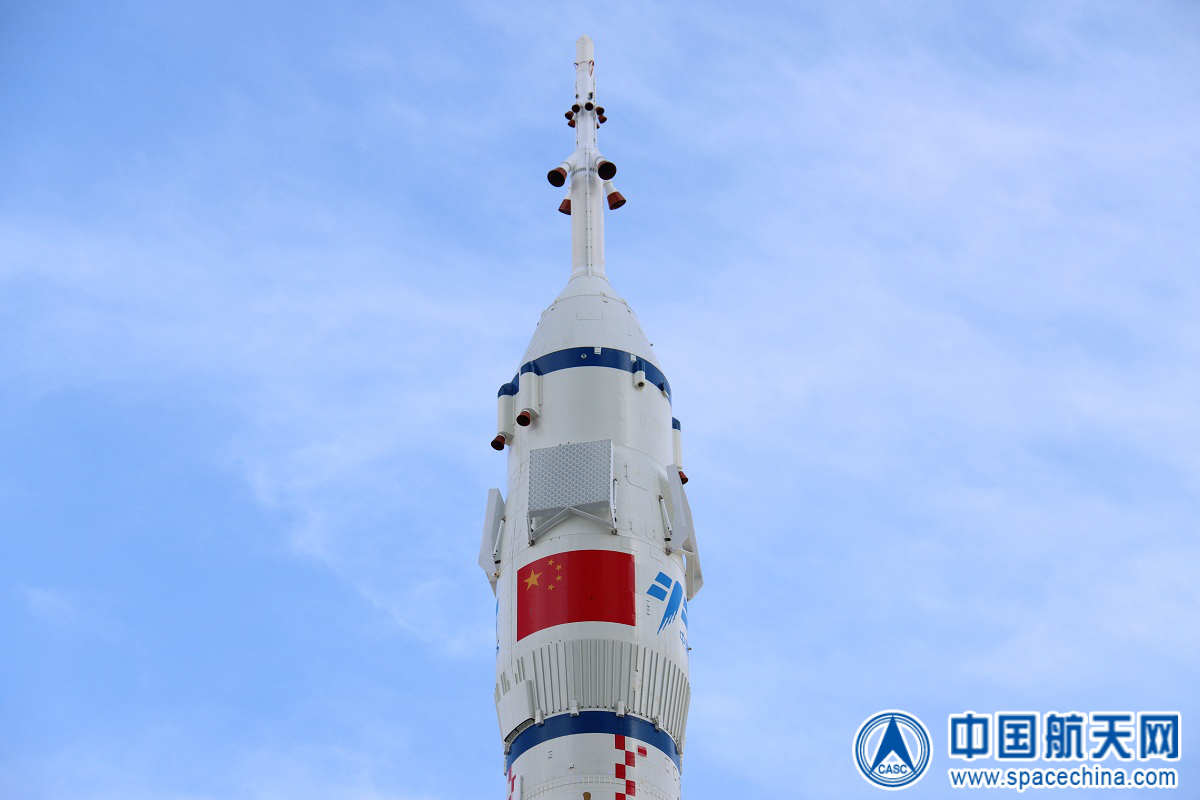
Watch Ken’s continuing reports about Artemis and NASA missions, SLS, Orion, SpaceX, Starlink, Commercial Crew and Starliner and Crew Dragon and onsite for live reporting of upcoming and recent SpaceX and ULA launches including Crew 1 & 2, Demo-2, ISS, X-37B, Solar Orbiter, Mars 2020 Perseverance and Curiosity rovers, NRO spysats and national security missions and more at the Kennedy Space Center and Cape Canaveral Space Force Station.
Stay tuned here for Ken’s continuing Earth and Planetary science and human spaceflight news: www.kenkremer.com –www.spaceupclose.com – twitter @ken_kremer – email: ken at kenkremer.com
Dr. Kremer is a research scientist and journalist based in the KSC area, active in outreach and interviewed regularly on TV and radio about space topics.
………….
Ken’s photos are for sale and he is available for lectures and outreach events
Please consider supporting Ken’s work by purchasing his photos and/or donating at Patreon:
https://www.patreon.com/kenkremer
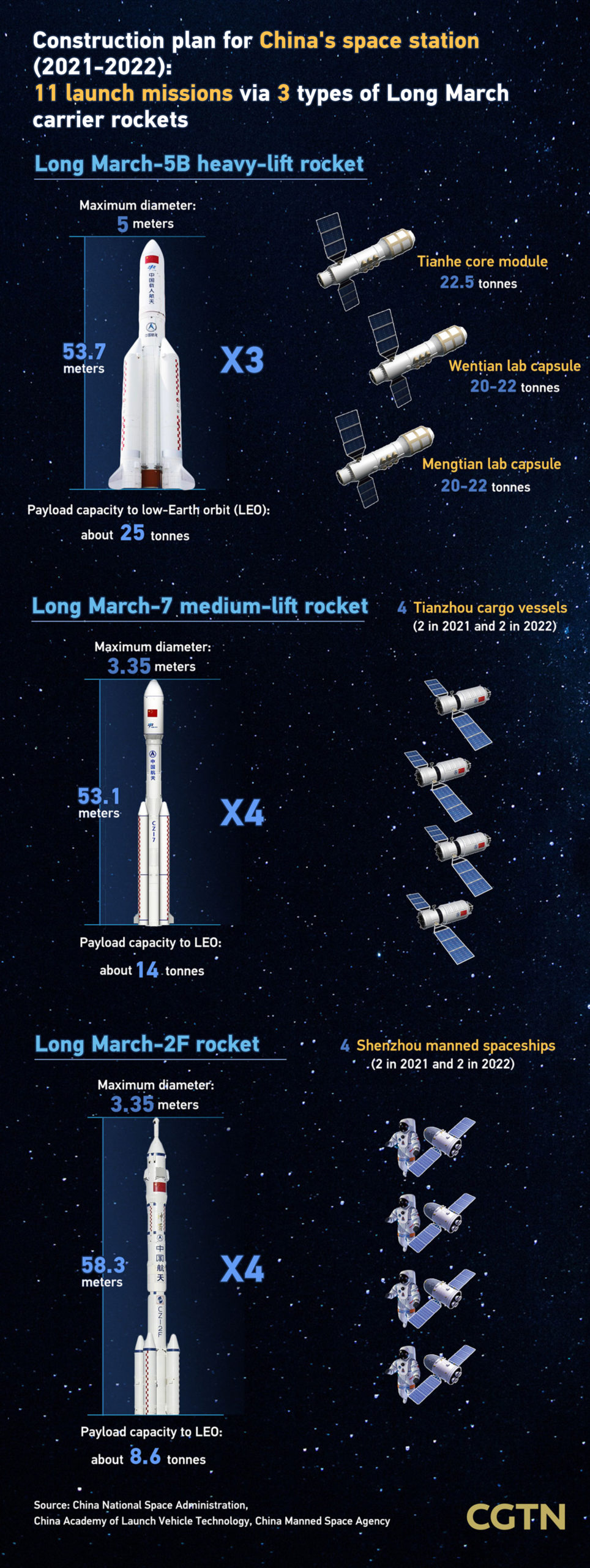
x



